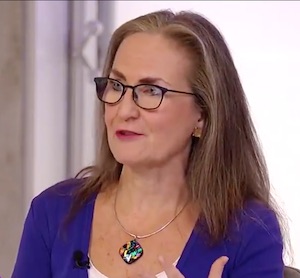This year’s RIMS ERM Conference will be held virtually on November 4 and 5, 2020, promising two days packed with informative sessions featuring global risk leaders. The conference kicks off November 4th with a live keynote delivered by Dr. Andrea Bonime-Blanc, founder of GEC Risk Advisory and the author of Gloom to Boom: How Leaders Transform Risk Into Resilience and Value. She will also answer questions from the audience during a live session on November 5th.

Dr. Bonime-Blanc recently appeared on RIMScast to discuss her upcoming keynote; the role technology has played in environmental, social and governance risks (ESG); and what risk practitioners must do to succeed today. Check out some highlights below, and download RIMScast episodes 100 and 101 for a deeper dive with Dr. Bonime-Blanc into topics such as diversity, strategic risk management and ways ERM practitioners can generate and retain value. If you’d like to watch her keynote and join RIMS for the rest of the ERM Conference 2020, registration is now open for all attendees.
How did you first begin using and implementing ERM in your career?
Dr. Andrea Bonime-Blanc: I was the general counsel of a startup within a much larger utility company, and we were the global division that was going all over the world in the mid- to late-1990s and early 2000s looking for electric power generation distribution opportunities. I became the risk manager because…[someone] needed to put the risk hat on. We ended up creating programs, policies, procedures to really perform risk management. Building power plants in the middle of the jungle of Colombia or negotiating a joint venture with a Chinese government corporation running a coal mine in northern China presents a number of risks.
When did you notice how vital it was to “wear the risk hat”?
AB-B: I’ll give you the example of an environmental, health and safety risk: When I was at PSEG, we went into a lot of different countries, including at least six or seven major Latin American countries that were privatizing their electric assets. There were competitions to acquire those assets in the first place, which created a whole bunch of risks from a standpoint of fraud and government corruption. I supervised the legal teams, and also led audit and finance teams. We had utility folks who understood the environmental, health and safety aspects of the assets we were looking at. There were cross-functional and cross-disciplinary teams that would work with the legal department and the general counsel’s office to figure out the risks involved with acquiring those potential assets. It showed how ERM done properly provides that way of collating and collecting really important, strategic information that is necessary at the highest levels of an organization.
How can diversity—of people and perspective—influence ERM in an organization?
AB-B: ERM is a collaborative process. It requires many different minds. A good ERM program will draw upon the knowledge of other key people and functions within an organization. If it’s a standalone program, it won’t work. Drawing on the knowledge and expertise and experience of your colleagues in different parts of the organization is crucial. Likewise, ESG plus T is all about understanding your non-financial issues as well as the risks that will have a financial impact.
You noted the addition of “T,” which stands for “technology”—why is technology so integral to ERM now, and how does it tie into your keynote?
AB-B: The technology piece has become so overwhelming, so suffusing, so minute-by-minute for us in the world that we live in—whether it’s negative like cyberattacks, or positive things, and there are so many other issues in between. We’re just starting to scratch the surface of both the negative and the positive in these technology issues.
Risk professionals have a role to play in creating the information that reaches the management and the board, and building a risk savvy culture. This includes building ERM that is integrated with the strategy of understanding the ESG+T issues that are part of your business, and how you integrate with crisis management and business continuity, for example. These are all pieces of the resilience model that I will share at the end of the keynote. It is something that risk professionals really need to understand, because it not only liberates you from your silo—if you’re in a silo—but it also demonstrates your value to the rest of the organization.
Similar Posts:
- Ahead of RIMS ERM Conference, Keynote Speaker Gretchen Anderson Talks Culture Change
- RIMS ERM Conference: A Q&A on the Future of ERM
- RIMS ERM Conference 2021: Introducing the New RIMS Maturity Model
- RIMS ERM Conference 2012 Comes to San Antonio
- RIMS ERM Conference 2021: Integrating Net Zero Commitments into ERM Plans
